Landscape Design
Patio of the Week
Native Plants
Yard of the Week: Native Prairies Inspire a Designer’s Landscape
A landscape architect brings his Illinois yard back to its roots with a pollinator-friendly prairie meadow
“My wife is a country girl, so it was her idea,” landscape architect Bob Hursthouse says, referring to the couple’s move from a Chicago suburb to the Kendall County countryside, about 60 miles west of the city. Their country homestead is about 1½ acres and borders an oak grove that is common property within their community. “I knew this land was once a lot of oak and hickory savannas and tallgrass prairies,” Hursthouse says. “I wanted to revive some of that history on the property.” The result is a lovely yard that includes prairie meadows, groves of trees and landscape materials that play off the Craftsman-style architecture of the house.
Before: The land had beautiful mature trees, but a lot of the property was covered in lawn. It was also bordered by woods with lots of oaks, harking back to the days of the oak savannas in the region. (This photo and the previous one were both taken on the right side of the driveway, but from slightly different spots.)
“It’s rare to have such grade changes on a property in our part of Illinois, but because of the nearby Fox River, the land rolls,” Hursthouse says. A drainage swale dips down 9 feet from the rest of the yard, then has a grade change of 5 feet up to the street. One attempt at mowing this had Hursthouse thinking about how he could look to the history of tallgrass prairies for design guidance.
“It’s rare to have such grade changes on a property in our part of Illinois, but because of the nearby Fox River, the land rolls,” Hursthouse says. A drainage swale dips down 9 feet from the rest of the yard, then has a grade change of 5 feet up to the street. One attempt at mowing this had Hursthouse thinking about how he could look to the history of tallgrass prairies for design guidance.
After: Hursthouse went all-in on the prairie idea, filling a significant portion of the front yard with pollinator attractors. He enlisted the help of his dear friend Grace Koehler, an expert in local native plants. “We just geeked out making lists of native plants — all the plants in the meadow are native to Kendall County,” he says. “I really wanted to restore what had been here before.”
With their plant palette determined, Hursthouse and Koehler grouped plugs (Popsicle-size potted seedlings) in a pleasing way and laid out the meadow together. Koehler has since passed away, but her memory lives on in the meadow. (This photo was taken in late summer about a year after the plugs were planted.)
Hursthouse also placed large boulders as steppingstones through the swale. These lead from the lawn through the meadow out to the street. Along the path, he placed a small circular seating patio made of decomposed granite (not shown) with Adirondack chairs.
With their plant palette determined, Hursthouse and Koehler grouped plugs (Popsicle-size potted seedlings) in a pleasing way and laid out the meadow together. Koehler has since passed away, but her memory lives on in the meadow. (This photo was taken in late summer about a year after the plugs were planted.)
Hursthouse also placed large boulders as steppingstones through the swale. These lead from the lawn through the meadow out to the street. Along the path, he placed a small circular seating patio made of decomposed granite (not shown) with Adirondack chairs.
In planning for the range of microclimates within the prairie, Hursthouse considered that “prairie is going to prairie,” meaning that certain plants will find their sweet spots, thriving and spreading accordingly. In the wetter areas of the swale, he planted moisture-loving plants such as flag irises and queen of the prairie (Filipendula rubra; USDA zones 3 to 8; find your zone).
Potentially, a new house could be built past the right side of the property someday, so he planted upright junipers with prairie selections around them. The prairie choices here, including big bluestem (Andropogon gerardii, zones 3 to 9), golden Alexanders (Zizia aurea, zones 3 to 8) and fall sunflowers, grow 7 to 8 feet high.
3 Productive Yards That Attract Pollinators
Potentially, a new house could be built past the right side of the property someday, so he planted upright junipers with prairie selections around them. The prairie choices here, including big bluestem (Andropogon gerardii, zones 3 to 9), golden Alexanders (Zizia aurea, zones 3 to 8) and fall sunflowers, grow 7 to 8 feet high.
3 Productive Yards That Attract Pollinators
Coming up with the right planting plan was tricky, as the prairie meadow has five climatic zones. “There was dry, gravelly south-facing soil; a north-facing area that drained faster; a shady area under a cluster of burr oaks; a hot, flat and dry area on top; and the wet swale,” he says.
He and Koehler planned each area accordingly, using over 40 native species of pollinator-attracting plants. “We have excellent local growers here,” Hursthouse says.
This photo was taken 13 months after planting the prairie along both sides of the existing driveway. “The blooming season starts in early spring with Virginia bluebells [Mertensia virginica, zones 3 to 8] and native columbines [Aquilegia sp.], and crescendos in late July to early August with rudbeckias, coneflowers [Echinacea sp.] and coreopsis,” Hursthouse says. In the fall, plants including Joe Pye weed (Eutrochium sp.) and two varieties of asters provide blooms, as seen here.
He and Koehler planned each area accordingly, using over 40 native species of pollinator-attracting plants. “We have excellent local growers here,” Hursthouse says.
This photo was taken 13 months after planting the prairie along both sides of the existing driveway. “The blooming season starts in early spring with Virginia bluebells [Mertensia virginica, zones 3 to 8] and native columbines [Aquilegia sp.], and crescendos in late July to early August with rudbeckias, coneflowers [Echinacea sp.] and coreopsis,” Hursthouse says. In the fall, plants including Joe Pye weed (Eutrochium sp.) and two varieties of asters provide blooms, as seen here.
Before getting closer to the house and the landscape around it, let’s get oriented. The street is on the right side of this plan, with the driveway leading up to the house. The large steppingstones through the swale are on the top-right part of the property. There’s a fountain in front of the house and a patio with a fire pit behind the house. There’s a second seating area with a fire pit toward the top-left of the property.
Regional history also inspired the circular fire pit area at the edge of the property — Hursthouse paid homage to landscape architect Jens Jensen’s council rings. Originally from Denmark, Jensen emigrated to the United States as a young man. He is best known as a key player in landscape architecture’s Prairie movement, and one of his signature design elements was the council ring — a circular gathering space ringed by a stone wall with an opening.
Hursthouse’s circular decomposed-granite patio is located between the field and the edge of a mature oak stand, sited in the type of spot Jensen usually chose for a council ring. Rather than being a circle surrounded by a low stone wall, this patio has a circular stone fire pit in the center, surrounded by Adirondack chairs. It’s a nice nod to Jensen, whom Hursthouse refers to as “our Midwestern guy.”
Regional history also inspired the circular fire pit area at the edge of the property — Hursthouse paid homage to landscape architect Jens Jensen’s council rings. Originally from Denmark, Jensen emigrated to the United States as a young man. He is best known as a key player in landscape architecture’s Prairie movement, and one of his signature design elements was the council ring — a circular gathering space ringed by a stone wall with an opening.
Hursthouse’s circular decomposed-granite patio is located between the field and the edge of a mature oak stand, sited in the type of spot Jensen usually chose for a council ring. Rather than being a circle surrounded by a low stone wall, this patio has a circular stone fire pit in the center, surrounded by Adirondack chairs. It’s a nice nod to Jensen, whom Hursthouse refers to as “our Midwestern guy.”
Before: “The 10-year-old house was so perfect that we felt as though these people built this house for us, but the landscape was a bust,” Hursthouse says.
After: “When I design the landscape around a house, I like to take cues from the architecture,” Hursthouse says. “The column bases and fireplace were cobbled granite, so I used cobbled granite on the fountain.” While the fountain stones are mortared, he used dry-stacked granite stones around the edge of the fountain for a looser, less formal look heading away from the entry. This created a nice transition between the entry terrace and fountain and the lawn below.
Find a local deck-and-patio specialist
Find a local deck-and-patio specialist
Hursthouse extended the existing bluestone on the porch floor and steps to a new entry terrace. This is bluestone in its full color range with plum added. It has a natural cleft, and the pieces are composed in a random pattern. This creates a cohesive experience underfoot from the driveway to the front door.
All the plants besides the mature trees are part of the new design. While the landscape architect came close to sticking with all natives, he wasn’t 100% pure. “Two exceptions to the all-native rule were Korean spice viburnum [Viburnum carlesii, zones 4 to 8] — because who can resist that? — and Tiger Eyes sumac [Rhus typhina ‘Bailtiger’, zones 4 to 8], which is a hybrid,” he says.
All the plants besides the mature trees are part of the new design. While the landscape architect came close to sticking with all natives, he wasn’t 100% pure. “Two exceptions to the all-native rule were Korean spice viburnum [Viburnum carlesii, zones 4 to 8] — because who can resist that? — and Tiger Eyes sumac [Rhus typhina ‘Bailtiger’, zones 4 to 8], which is a hybrid,” he says.
The fountain idea was born out of necessity, as the couple needed a spot for their prized koi fish. It is 3 feet deep and 10 feet in diameter.
The feature also gave the couple a chance to install something they had long admired. Hursthouse first came across a sugar kettle repurposed into a fountain in New Orleans years ago. “I said, ‘Wow! What is that?’” he says. Sugar kettles, also known as syrup kettles, are cast iron kettles that were used in the past to cook down sugar cane to make sugar. Then they were repurposed as planters and fountains, and the look caught on.
Now the graceful sugar kettle shape is popularly produced new for garden uses. This home finally gave Hursthouse a chance to have one of his own. This fountain is cast iron and is by Grove Kettles. It is 3½ feet in diameter across the top.
Browse outdoor fountains in the Houzz Shop
The feature also gave the couple a chance to install something they had long admired. Hursthouse first came across a sugar kettle repurposed into a fountain in New Orleans years ago. “I said, ‘Wow! What is that?’” he says. Sugar kettles, also known as syrup kettles, are cast iron kettles that were used in the past to cook down sugar cane to make sugar. Then they were repurposed as planters and fountains, and the look caught on.
Now the graceful sugar kettle shape is popularly produced new for garden uses. This home finally gave Hursthouse a chance to have one of his own. This fountain is cast iron and is by Grove Kettles. It is 3½ feet in diameter across the top.
Browse outdoor fountains in the Houzz Shop
Here Hursthouse enjoys the view from the front porch out to the fountain and the prairie beyond.
Before: The back porch also had a bluestone surface, but the cracked concrete patio left a lot to be desired.
After: A new bluestone patio has a dining area to the left, a gas fire pit to the right and a grilling area close to the porch. The couple’s two pooches love the country life. Treasure is seen here lying at Hursthouse’s feet, and Ransom can be seen behind the potted tree on the left.
Shop for Adirondack chairs
Shop for Adirondack chairs
The grilling station has a dual gas range from American Muscle Grill; its face was designed to look like a Shelby Cobra car grille. The countertops are honed bluestone. Hursthouse played off the home’s architecture by covering the base in clapboard that matches the house.
Because of the rolling land in the Fox River Valley, the property has a 25-foot grade change from the street to the back. In response, Hursthouse pushed the back of the patio into the slope and created a retaining wall composed of granite steps, granite columns and a cobbled-granite planter to terrace the back lawn. Another notable detail here is that the fire pit and planter have bluestone coping.
The dining table was born of architectural salvage. When Hursthouse saw on a job site that some old limestone columns had been demolished and were in a pile to be disposed of, he saved the capital, the base and another part of a column, and transformed the pieces into the table base. He then had a 4-foot-square piece of bluestone cut into a circle to create the top, adding a bullnose edge to it. This is not a table that can be moved around on a whim. In fact, he had to place a 42-inch-deep pier underneath the patio to support its weight.
Check out our beginner’s guide to get started on your home project
The dining table was born of architectural salvage. When Hursthouse saw on a job site that some old limestone columns had been demolished and were in a pile to be disposed of, he saved the capital, the base and another part of a column, and transformed the pieces into the table base. He then had a 4-foot-square piece of bluestone cut into a circle to create the top, adding a bullnose edge to it. This is not a table that can be moved around on a whim. In fact, he had to place a 42-inch-deep pier underneath the patio to support its weight.
Check out our beginner’s guide to get started on your home project
The couple also added copper gutters with rain chains to their home. “Rain chains are just fun,” Hursthouse says. While he and his wife may be farther from the excitement of Chicago here, living in the country has provided its own kind of fun, as well as a deeper connection to the landscape. Jens Jensen surely would have appreciated the regard for history, ecology and indigenous plants.
More on Houzz
Read more landscape stories
Browse more landscape photos
Shop for your outdoor spaces
More on Houzz
Read more landscape stories
Browse more landscape photos
Shop for your outdoor spaces

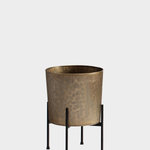
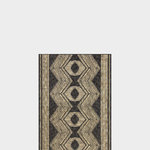








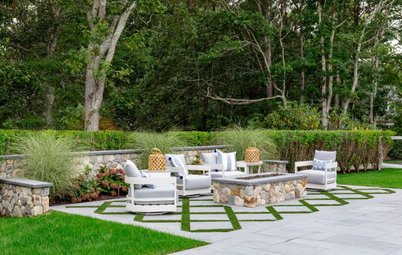
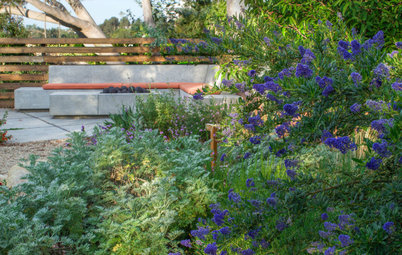
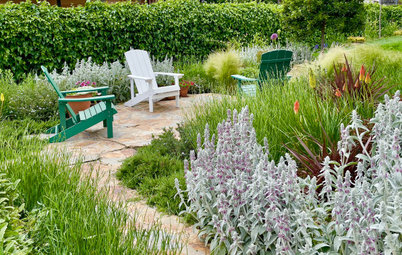
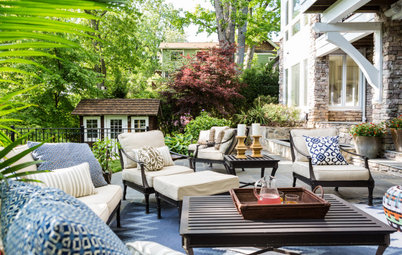
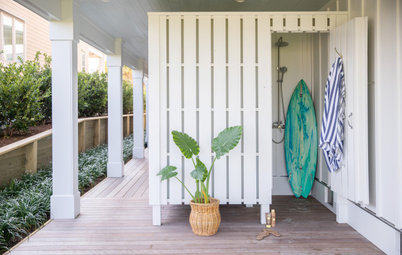
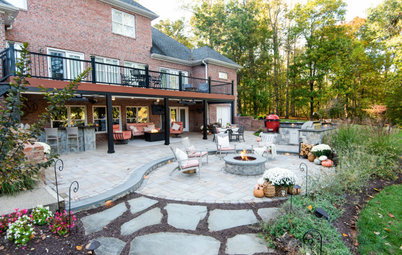
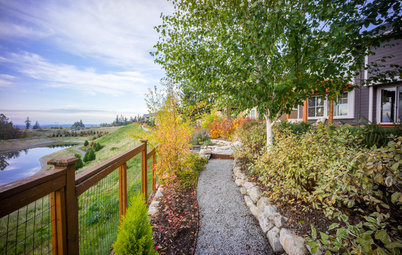
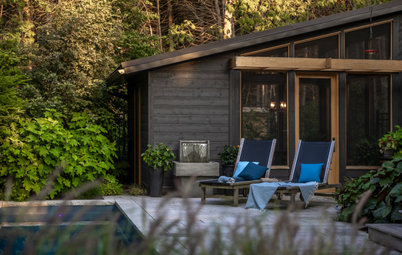
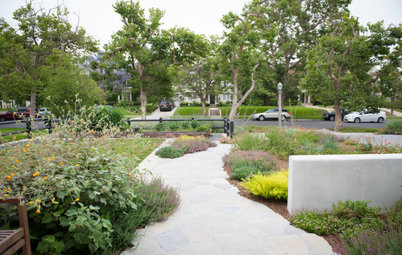
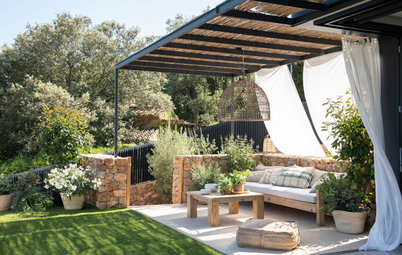

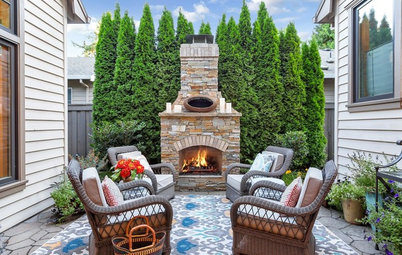
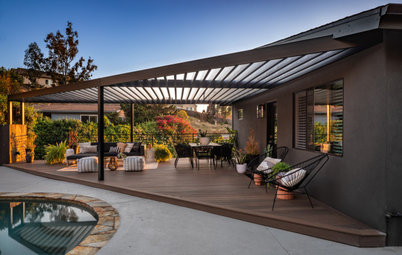
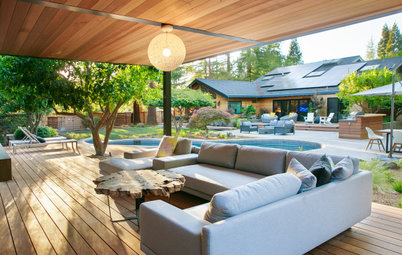





Yard at a Glance
Who lives here: Bob and Robbi Hursthouse
Location: Millbrook, Illinois
Size: 1½ acres (0.6 hectares)
Landscape architect and builder: Hursthouse Landscape Architects and Contractors
The first major landscape project Hursthouse and his wife tackled here was establishing a prairie meadow. The house is tucked back from the street, and the meadow in front is full of pollinator-attracting native plants. Plants bordering the long driveway add a variety of scents when they’re in bloom.
Find a local landscape designer on Houzz